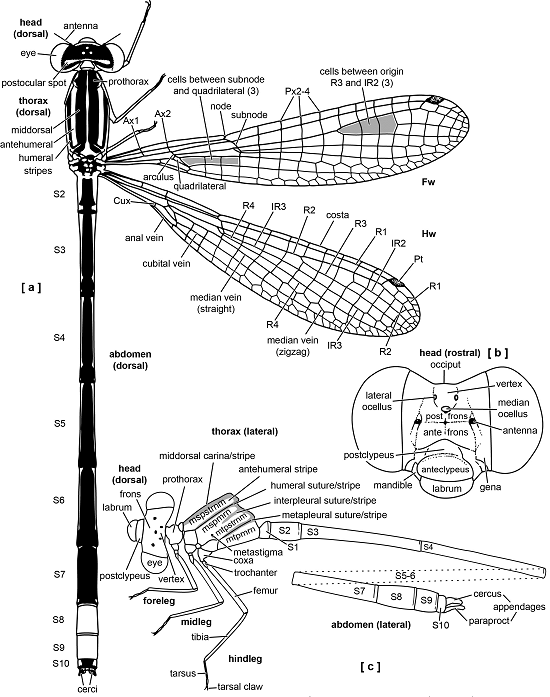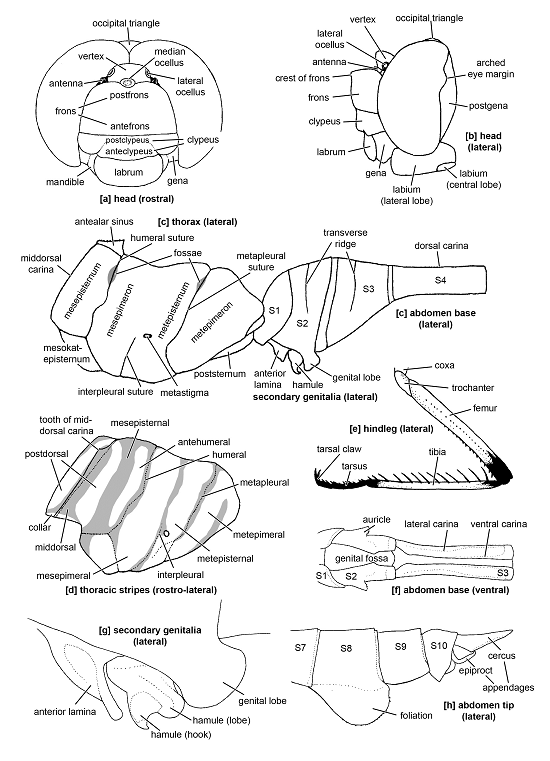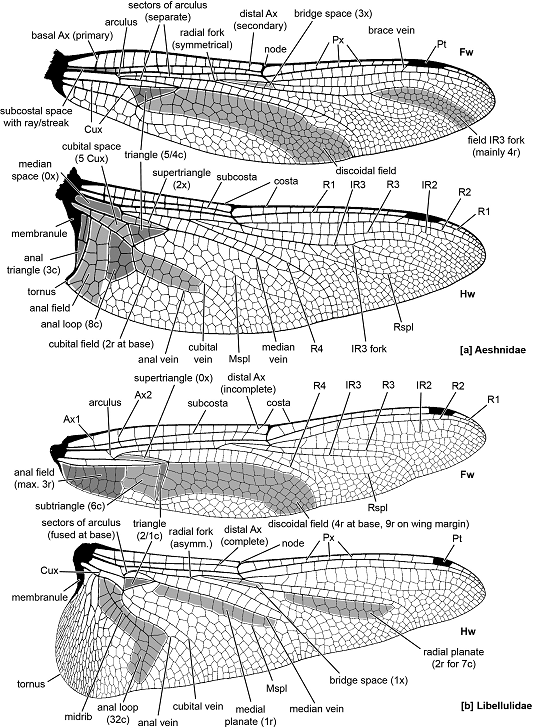Identifying Odonata
Words of warning!
Most species’ identifying characters are visible with a hand lens (10x), although greater magnification is often preferable. With experience the majority of species can be recognised in the field, many even by sight.
The diagnoses on ADDO are generally for (mostly mature) males only! Also keep in mind that, while photographs of many species are included, females are illustrated only occasionally. Fortunately about three-quarters of dragonflies encountered in the field are males. Identification of females is more difficult and is still poorly understood for some genera. Many characters, like venation and markings, apply to females almost as well as males (although, for instance, the anal triangle and angle of many anisopteran males is absent). Characters of pruinosity, bright colours and of course genitalia are generally male-specific.
Individual variation is substantial! Age and environment are the main causes. At emergence, dragonflies are soft and shiny (this condition is called teneral) and have still to develop the bright colours of mature adults. Also, in many species microscopic scales of reflective wax develop on the thorax and/or abdomen. This pruinosity appears in different shades of white, grey or blue, depending on structure and density. Thus a dragonfly that is yellow with black markings at emergence may become entirely blue at maturity, or bright red. Otherwise the three most variable features are: (1) extent of black markings; (2) numbers of cross-veins and cells in the wings; and (3) size.
Measurements and counts given are approximate! For example, the hindwing (Hw) length (measured from base of costa to tip) or the number of antenodal cross-veins (Ax) must be regarded as an indication of scale, not as a species’ total range. Data may originate from few or unvalidated sources. Many species and regions are poorly known and therefore variation may be even greater than currently recognised. Only known exceptions are indicated.
We have largely refrained from using internal microscopic characters. Penis characters are given only for some damselfly genera. In specimens that are freshly dead (preferred), stored in alcohol or softened with warm water (when dry) the penis can be levered out easily with a fine pin (see instructions under preservation of adults).
Abbreviations and morphological synonyms (=)
For naming wing veins we adopt a simplified version of the much-used Tillyard-Fraser terminology, abbreviating only the medial and radial supplements (Mspl, Rspl), the multiple branches of the radius (R1-4; IR2-3) and the antenodal, cubital and postnodal cross-veins (Ax, Cux, Px).
Ax, Cux, Px and abdominal segments are all numbered from the base, e.g. Ax2 is the second antenodal cross-vein from the base and S8-10 represents the eighth, ninth and tenth (thus the terminal three) abdominal segments.
Abd: abdomen
Antehumerals: antehumeral stripes
Ax: antenodal cross-vein(s)
Cerci = superior appendages
Cux: cubital cross-vein(s) = Ac, anal crossing
Epiproct = inferior appendage (Anisoptera)
Fw: forewing(s)
Hamule = posterior hamule (Macromiidae, Libellulidae)
Humerals: humeral stripes
Hw: hindwing(s)
Paraprocts = inferior appendages (Zygoptera)
Pt: pterostigma(s)
Px: postnodal cross-vein(s)
S: abdominal segment(s)
Thorax = synthorax
Wing vein nomenclature
The layout of the fore- (Fw) and hindwings (Hw) is similar. To indicate this and the degree of variation of various structures, we provided annotated pairs of wings from the two most disparate Anisopteran families. Annotations in brackets show how wing characters must be read, e.g. how many cells (c), cell-rows (r) or cross-veins (x) there are in a particular field. The part of the wing between the base and node is called ‘antenodal’, that between the node and pterostigma (Pt) ‘postnodal’. Most antenodal cross-veins (Ax) have a section anterior (‘costal’) and posterior (‘subcostal’) of the subcosta; postnodal cross-veins (Px) only have the costal sections.
Indicating relative positions
Rostral, dorsal, lateral, ventral and caudal refer to views or positions on or towards the face, upperside (dorsum = back), sides, underside (venter = belly) and tail-end respectively. Anterior and posterior indicate relative positions towards the front end (head) and back end (abdomen) of the animal. Proximal and distal refer to positions towards and away from the body, basal and apical to positions at the base or tip of a structure (e.g. segment or wing), and subbasal and subapical to positions near the base or tip. Medial is used for positions in-between extremes, e.g. roughly halfway between basal and apical.





